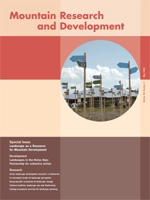Special Issue: Landscape as a Resource for Mountain Development
Editorial (1)
Development (5)
Research (5)
MountainPlatform (1)
MountainNotes (2)
MountainMedia (8)

No abstract available
No abstract available
No abstract available
No abstract available
No abstract available
No abstract available
No abstract available
No abstract available
No abstract available
No abstract available
No abstract available
